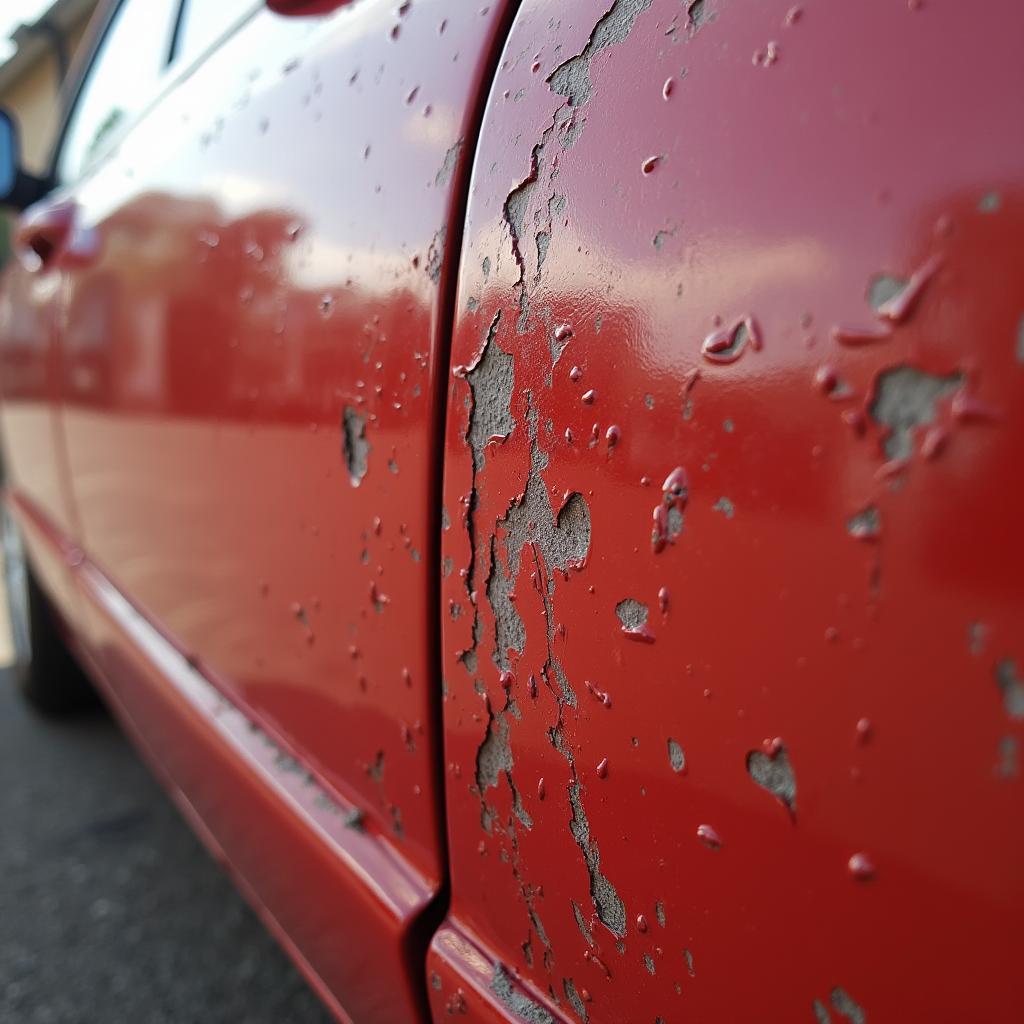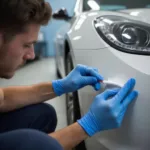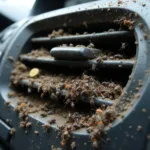Discovering a scratch on your car’s paint can be disheartening. Whether it’s a minor graze or a deeper gouge, these blemishes can detract from your car’s appearance and potentially impact its resale value. Fortunately, you don’t always need a professional to repair car scratch paint. With the right tools, techniques, and a bit of patience, you can often address these imperfections yourself. This guide will provide a comprehensive overview of how to repair car scratch paint, from assessing the damage to achieving a flawless finish.
Assessing the Scratch: How Deep Is Too Deep?
Before you begin any repair process, it’s crucial to determine the severity of the scratch. Car paint typically consists of four layers: clear coat, base coat, primer, and metal.
- Clear Coat Scratches: These are the most superficial, affecting only the clear coat layer. They often appear white or lighter than your car’s paint and can often be buffed out with a polishing compound.
- Base Coat Scratches: These penetrate the clear coat and into the colored base coat. You’ll see the actual color of your car in the scratch. Repairing these usually involves touch-up paint and clear coat.
- Primer Scratches: Deeper scratches expose the primer underneath the base coat, often appearing gray or white. These require more involved repairs, including sanding, priming, and repainting.
- Scratches Reaching the Metal: The deepest scratches expose the bare metal of your car. These are the most serious and require immediate attention to prevent rust.
DIY Repair Car Scratch Paint: Essential Tools and Materials
Once you’ve assessed the scratch, you can gather the necessary tools and materials to tackle the repair:
- Cleaning Supplies: Car wash soap, microfiber towels, rubbing alcohol, masking tape, and a detailing brush.
- Sandpaper: 2000-grit, 3000-grit sandpaper, and a sanding block (for deeper scratches).
- Touch-up Paint: Obtain the exact color code for your car’s paint and purchase a touch-up paint pen or bottle from a reputable supplier.
- Clear Coat: For scratches that reach the base coat or deeper.
- Polishing Compound: Used to buff out minor scratches and blend the repair.
- Wax: To seal and protect the repaired area.
Step-by-Step Guide to Repair Car Scratch Paint
1. Clean the Area: Thoroughly wash the scratched area with car wash soap and water. Use a detailing brush to remove any dirt or debris lodged inside the scratch. Dry the area with a microfiber towel.
2. Sanding (If Necessary): For deeper scratches that reach the primer or metal, you’ll need to sand the area. Start with 2000-grit sandpaper, using light, even strokes in the direction of the scratch. Gradually move to 3000-grit sandpaper for a smoother finish.
3. Clean Again: Once sanding is complete, clean the area again with rubbing alcohol to remove any sanding dust or residue.
4. Apply Touch-up Paint: Using a steady hand, carefully apply the touch-up paint to the scratch. Use thin layers, allowing each layer to dry completely before applying the next.
5. Apply Clear Coat (If Needed): For scratches deeper than the clear coat, apply a thin layer of clear coat over the dried touch-up paint. Let it dry completely.
6. Wet Sanding (Optional): If there’s any unevenness after the clear coat dries, you can use 3000-grit sandpaper and soapy water to wet sand the area. Be gentle and avoid sanding through the clear coat.
7. Polishing: Apply a small amount of polishing compound to a clean microfiber cloth and gently buff the repaired area in circular motions. This will blend the repair and remove any imperfections.
8. Waxing: Finally, apply a layer of car wax to the entire repaired area to seal and protect the paint.
When to Call a Professional
While DIY repairs can effectively address minor to moderate scratches, some situations warrant professional intervention:
- Extensive Damage: Deep scratches covering a large area are best left to professionals.
- Rust: Any signs of rust require immediate attention from a qualified auto body shop.
- Dents: If the scratch is accompanied by a dent, professional repair is necessary.
- Lack of Confidence: If you’re unsure about any step of the repair process, it’s best to consult a professional.
Preventing Future Scratches
Prevention is always better than cure. Here are some tips to protect your car’s paint from future scratches:
- Regular Washing and Waxing: A clean and waxed car is less susceptible to scratches.
- Covered Parking: Park in a garage or under a carport whenever possible.
- Avoid Tight Spaces: Be mindful of your surroundings and avoid parking in tight spaces where your car could be easily scratched.
- Careful Driving: Maintain a safe distance from other vehicles and be cautious when navigating narrow roads or driveways.
Conclusion
Repairing car scratch paint can seem daunting, but with the right information and tools, it’s a manageable task for many car owners. By following the steps outlined in this guide, you can effectively address minor to moderate scratches, restoring your car’s appearance and protecting its value. Remember, if you encounter a situation beyond your comfort level, don’t hesitate to seek the expertise of a professional auto body shop.



